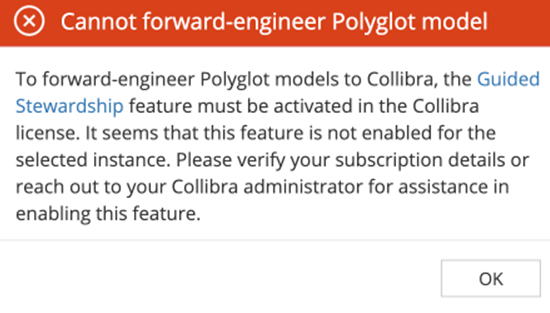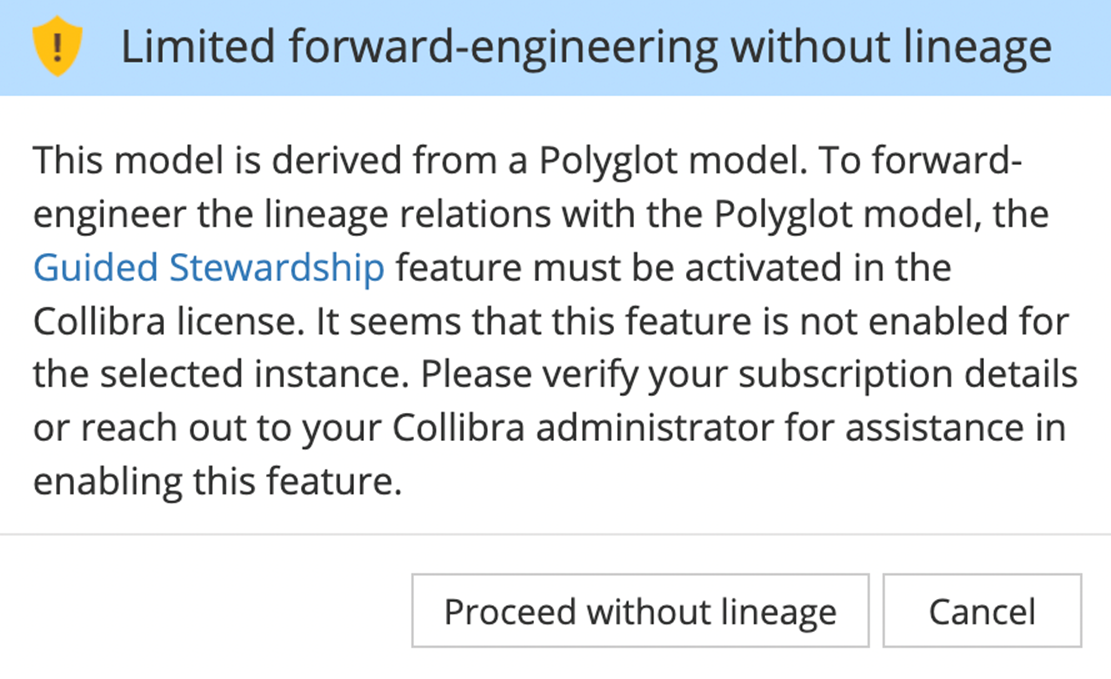Non-Ultimate edition integration
If you do not have the Ultimate package and did not get the Federated Operating model add-on, then starting with v8.3.6, we provide an integration, albeit with some graceful degradation, some limitations, and some required manual configuration.
The primary limitation is that it is impossible to publish Hackolade Studio polyglot data models to the Logical Layer of Collibra, in support of their Guided Stewardship operating model, or of course the related lineage relations.

And without Guided Stewardship on the Collibra instance, it is not possible to publish lineage from physical models to polyglot models (since polyglot models cannot be published to Collibra...):

Publishing physical data models to the Physical Layer of Collibra is possible. The process is identical for Ultimate and non-Ultimate editions of Collibra. Please refer to the main pages above for more details.
However, additional configuration is required on the Collibra side if you don't have the Ultimate edition subscription.
Additional Collibra configuration
When publishing a Hackolade Studio physical data model to Collibra, several Hackolade-specific assetType characteristics are created in Collibra. With non-Ultimate edition instances, these are not visible by default. They must be manually mapped to Collibra attributes to ensure that they are included in the layouts of the following asset types:
- Schema, Table, Column, Database View
- Data Model, Data Entity, Data Attribute - for users who publish Polyglot models and have the Guided Stewardship feature enabled, but do not have an Ultimate subscription.
To add a characteristic to an asset type layout
- Open Collibra Settings.
- Go to the Asset Types page and click the asset type you want to customize.
- Select Global Assignment → Characteristics, then click the Edit Layout button in the top-right corner.
- In the Edit Layout page, click Add a Characteristic, find the desired characteristic, check Add directly to the layout, and click Add.
Adjust the characteristic position if necessary.
This short video illustrates the process.
This process must be repeated for each of the following characteristics that you wish to see in Collibra for published Hackolade Studio data models:
Schema / Data Model:
- Description
- HCK Data Source Type
- HCK Technical Name
- HCK Activated
- URL
- Any custom Hackolade container/schema properties that mapped to characteristic with the HCK Custom prefix (My own attribute - in Hackolade -> HCK Custom My own attribute - in Collibra)
Table / Data Entity / Database View:
- Description
- HCK SELECT AS / Pipeline
- HCK Technical Name
- HCK Activated
- Any custom Hackolade entity properties that mapped to characteristic with the HCK Custom prefix (My own attribute - in Hackolade -> HCK Custom My own attribute - in Collibra)
Column / Data Attribute:
- Data Type
- HCK Data Type(s)
- HCK Activated
- HCK Technical Name
- Description
- Description from source system
- Size
- Number of Fractional Digits
- Is Nullable
- Char Octet Length
- Is Primary Key
- Is Auto Incremented
- Primary Key Name
- Default Value
- Personally Identifiable Information
- Security Classification
- Minimum Value
- Maximum Value
- Minimum Text Length
- Maximum Text Length
- Date and/or Time Pattern
- Any custom Hackolade field properties that mapped to characteristic with the HCK Custom prefix (My own attribute - in Hackolade -> HCK Custom My own attribute - in Collibra)